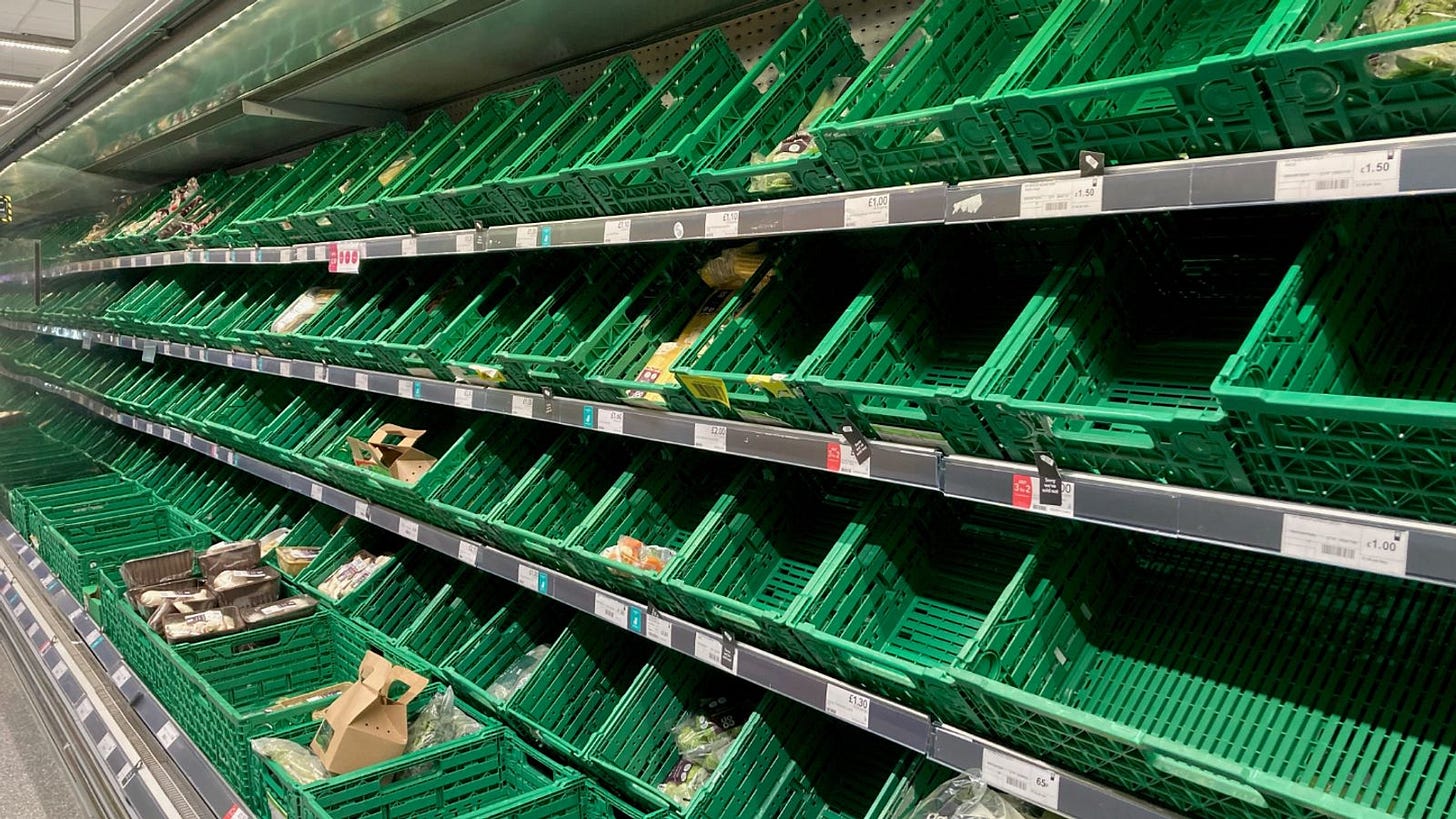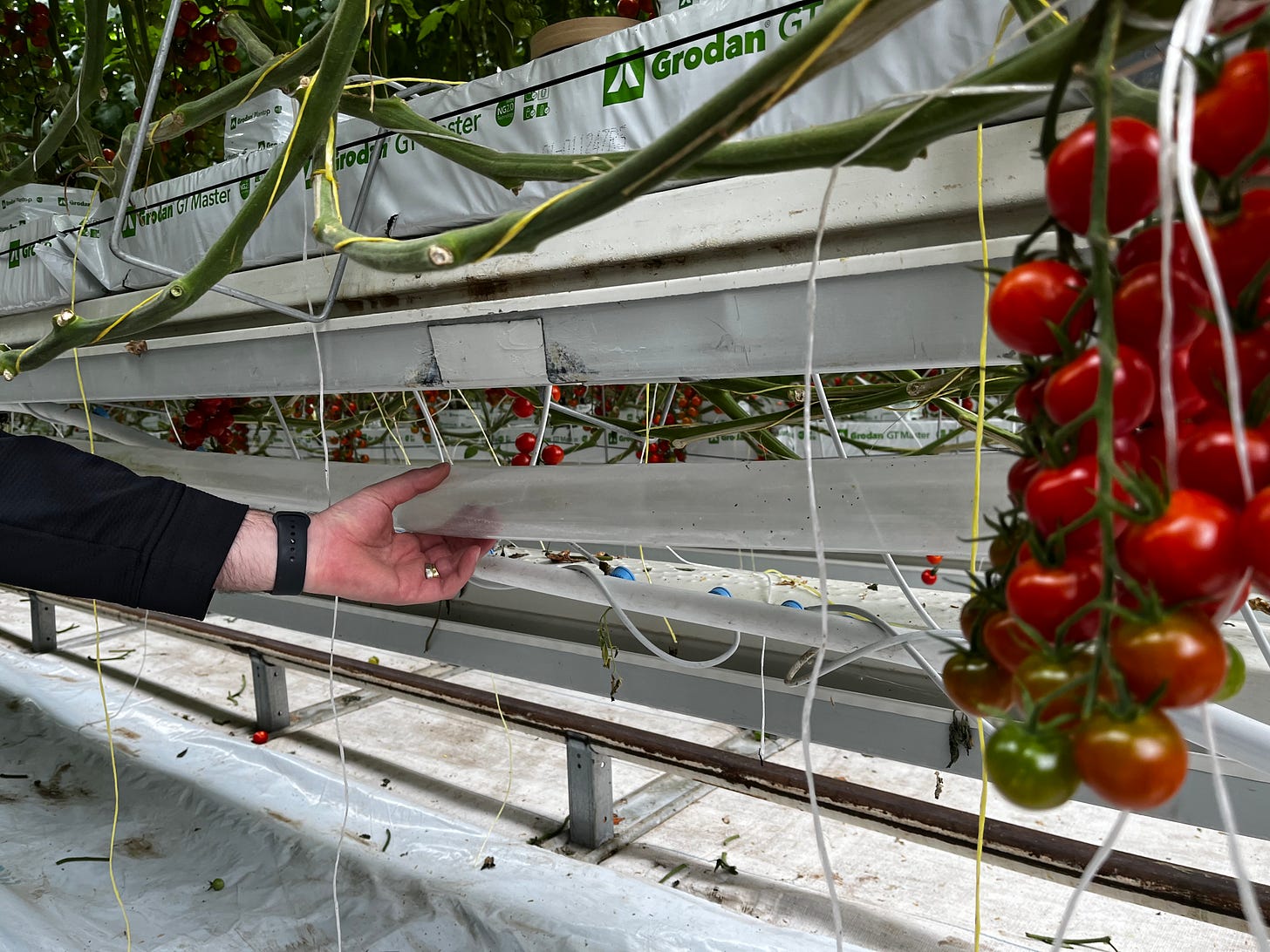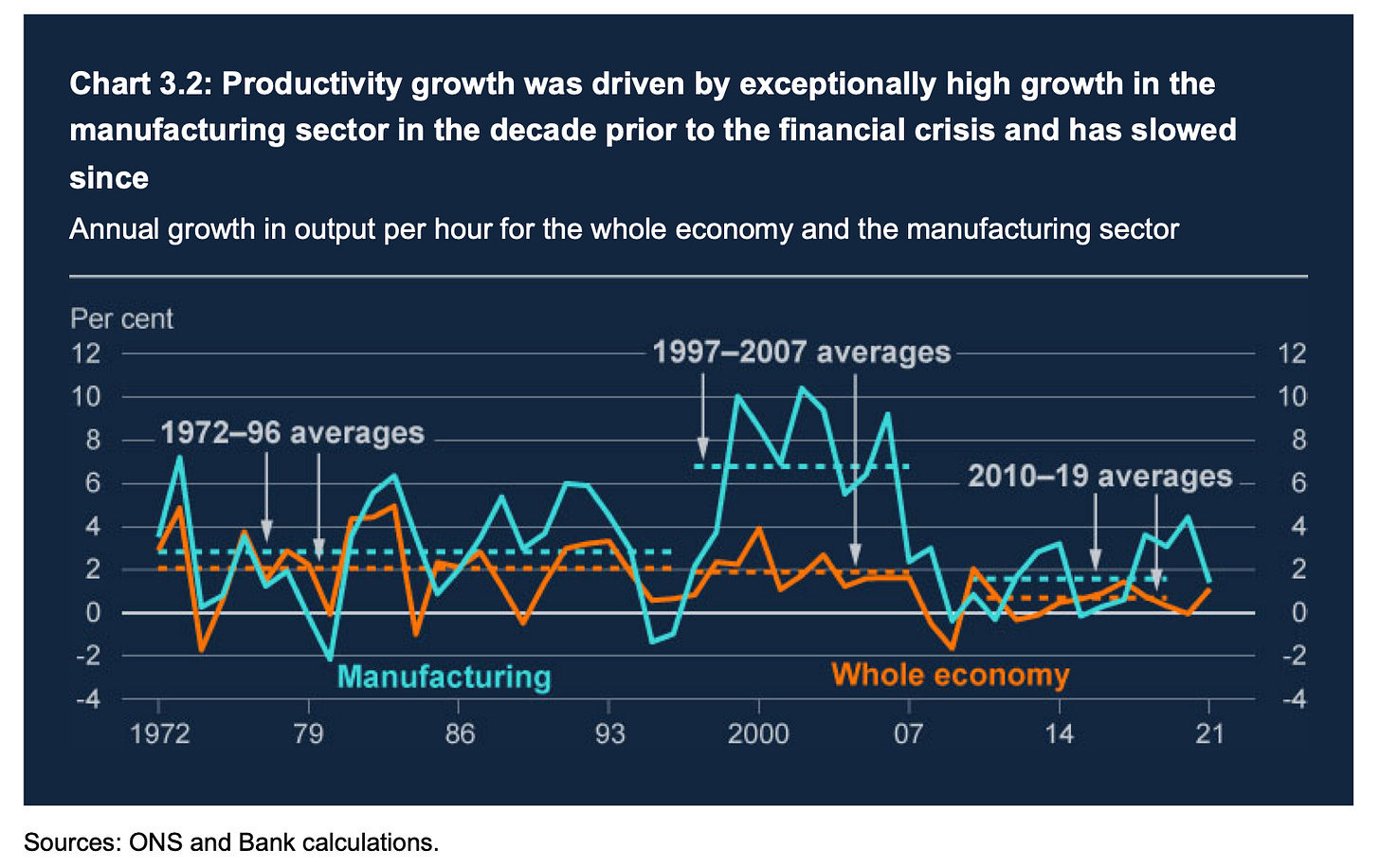It’s the Energy, Stupid
If you want to understand one of the main driving forces behind the economy, follow the tomatoes...
In case you hadn’t noticed, Britain is currently in the midst of a tomato famine. There’s a desperate shortage of tomatoes, lettuce and peppers, leaving supermarket shelves empty and forcing some of the country’s biggest retailers to consider rationing their precious vegetables.
The proximate explanation for this is bad weather in North African countries like Morocco and in the south of Spain, whence we get many of our vegetables this time of year. Some have also blamed Brexit, which has gummed up the mechanisms of trade and customs. They’re almost certainly right: while Brexit is rarely the only explanation for our economic underperformance, it’s invariably part of the explanation.
But there’s something else going on here too - something even more important. One of the main lessons that’s permeated my time writing about the Material World is the critical importance of energy. I started off assuming I was writing a book about six key materials; I ended up writing a book not just about those materials but about the energy transitions we’ve gone through in recent centuries to turn them into the amazing products we use every day. Energy became one of the overarching themes of the book - especially since we’re about to embark on an energy transition which involves trying to re-do the Industrial Revolution all over again.
Of course, in a strict sense, all economic activity is a form of energy transfer: we deploy energy - human, animal, fuel and chemical - to get stuff done. Energy is an essential factor in the production of goods and services.
Yet we often overlook just how much this force permeates every part of the economy, even unexpected places like tomatoes. To see why, you need to understand where we get our veg from these days. Incidentally, I’m using tomatoes as the main example here, because they are the most consumed of all vegetables, but much of the below applies just as equally to lettuces, peppers, cucumbers and a fair number of other salad vegetables.
Most of the tomatoes grown in the UK are cultivated not in the great outdoors but in vast greenhouses such as this one in the Lea Valley just outside London. They are mammoth structures, most of them built using designs and materials pioneered by the Dutch. Fly over the Netherlands and what you see is much of the countryside covered not with fields but with these glasshouses, many of them lit up with LED lights.
The advantage of growing plants in these places is that you can control the environment in almost every respect: the temperature, the humidity, the amount of light. You minimise the chances of parasites and hence the need for chemical intervention. And while spraying fertiliser on open ground is an inherently inefficient business, with much of the stuff draining off into rivers, in a hydroponic greenhouse you deploy far less fertiliser and it does far more.
So what has all of this got to do with energy? Actually, rather a lot. Take the greenhouse I visited in the Lea Valley. It’s heated with hot water pipes fed from an enormous gas boiler just outside the glasshouse.
The atmosphere inside has elevated levels of CO2 (to aid photosynthesis), with that CO2 also coming from the flue of the boiler - a clever wheeze the Dutch came up with a few years ago. Tomatoes in particular love CO2, so the higher you get the levels in the greenhouse, the faster they grow. Gas, in other words, is an incredibly important input to tomato growing, both for heat and for this photosynthetic boost. The vast majority of greenhouses in the UK, North Europe and for that matter the US use gas boilers precisely like this.
But it doesn’t end there, because the nitrogen fertiliser which is dissolved and then piped into the rock soil substrate upon which the vines are growing is also a fossil fuel product. The vast majority of the world’s nitrate fertiliser is made via the Haber Bosch process, probably the single most important chemical process in the world.
While ammonia, the main output from Haber Bosch, isn’t one of the six materials I cover in Material World it is something of a supporting actor throughout the book. For good reason: we would be unable to support half the planet’s population without the nitrate fertilisers we current manufacture using this obscure chemical process. It’s a massive, massive deal - and if you’re interested and can’t wait for my book, do read this absolutely brilliant account of the nitrogen cycle in The Economist. And right now the main physical feedstock for the process is, you’ve guessed it, natural gas.
Tomatoes, in other words, are a fossil fuel product in three dimensions. And while we don’t tend to think about farmers as energy users, actually this is among the biggest costs for a greenhouse grower such as you find in the north of Europe. All of which is why the spike in gas prices has caused a dramatic shift in where we get our tomatoes from.
More than half the greenhouses in the Lea Valley were left empty last year - something totally unprecedented. Similar story in the Netherlands and elsewhere in Europe. Some growers gambled that they could afford the costs; others just gave up.
And you can see the impact in this chart. European imports of tomatoes, which had been pretty much flat for most of the previous decade, leapt sharply higher. And where did most of those tomatoes come from? Well, many of them came from North Africa, the very place which is now facing problems with its harvest.
The point here is that were it not for higher energy costs, the UK would, all else equal, have grown more of its own tomatoes and hence wouldn’t have been quite so exposed to this. Energy is everywhere, including where you least expect it.
And this gets to a broader point, which necessitates showing you a couple more charts. Before we get to the first one, recall the conventional wisdom about Britain’s (and much of the developed world’s) productivity crisis. It’s that we’re facing an ever-decreasing rate in our economic bang-for-buck which is leaving us ever worse off. Picture a line getting lower and lower with each year that goes by.
But this chart, from the Bank of England’s latest Monetary Policy Report actually tells a subtly different story. Yes, when you look only at the red line - whole economy productivity - the growth rate is gradually falling ever lower. The red dotted lines drop, drop, drop.
But now look at the light blue line, showing you manufacturing productivity growth. The striking thing about this line is that it isn’t exactly telling you a story of constant decline. There’s something else going on. In fact, there was a period in the late 1990s/early 2000s when manufacturing productivity was rising really fast. The question is whether that was just an outlier, and what lay behind it.
Now, when you read articles these days trying to explain how we might boost our output-per-hour they often talk about stuff like skills or regulations or Brexit or subsidising R&D or lowering business taxes. This is all very well - all of this stuff might help. But as I stared at that Bank of England chart the other day, I was reminded of another chart altogether.
This one 👆 shows you the average energy prices paid by industry over the years. That’s the black line. Squint a bit and you can probably see what I saw: the line stops rising in the mid-1990s and begins to fall, all the way through to the mid-2000s. Now go back and look at the Bank of England chart. Hmm: the period with falling energy prices corresponds nearly precisely with the period when UK manufacturing productivity was going gangbusters.
Interesting, right? Now it’s possible this is simply correlation rather than causation, or even just a complete coincidence. Then again, might it be possible that the two things are connected? After all, we know from experience, and from our tomatoes, that energy matters rather a lot. So might it also follow that cheap energy prices were at least part of the explanation for why productivity in the manufacturing sector - the very part of the economy most exposed to energy costs - jumped in the late 1990s and early 2000s? Might the very sharp increase in energy costs thereafter help explain why manufacturing productivity has cratered ever since?
The other week the Chancellor, Jeremy Hunt, did a big speech on the economy. It was cast as a “vision” speech, where he’d set out his plan for how to boost our productivity. It was, he said, all about the “Four ‘E’s of economic growth and prosperity”. There was Enterprise, he said: we have to boost entrepreneurialism. There’s education - we need to boost skills, not to mention employment: creating jobs. As he went on I wondered for a moment whether his final E might be energy.
Perhaps he’d note that it’s everywhere in the economy, and that without an energy strategy, the government had no hope of building a new Silicon Valley. Semiconductors, he might add, take a massive amount of energy to produce. He’d acknowledge that the lesson from the Russia-Ukraine war and its economic consequences was that we should all spend a little more time pondering the importance of energy.
But, of course, he didn’t. The final E was… everywhere: “ensuring the benefits of economic development are felt not just in London and the South-East but across the whole of the UK.” The Chancellor’s four Es are all admirable goals, but you don’t go far in the Material World without realising that in the end a lot comes back to that other E.
On the bright side, we’re getting better and better at deploying energy more efficiently. The amount of energy it takes to produce a given dollar of output has been falling in the rich world for some time. That’s great news. But just because we’re getting comparatively more efficient doesn’t mean we can do without this stuff. In fact if you want to make stuff it’s still one of the most important inputs of all.
Consider what it takes to make a solar panel. Turning silicon into the ultra-pure wafers that eventually become a voltaic cell is an incredibly energy-hungry task - something I talked about a little bit when I was on Talking Politics a while back. This IEA chart visualises it quite well:
The yellow bars here show how much of the cost of each solar panel is energy (the other colours are showing you how much of the cost is raw materials). The top section is talking about the cost of manufacturing polysilicon, the ultra-pure substrate that goes into these modules. That’s pure energy. And energy costs are really high for the other manufacturing stages too.
You see this across the piece with new technology these days. You can’t make batteries, solar panels or for that matter wind turbines without a lot of energy. Same thing, by the way, for fertilisers. These days not only is Europe importing more tomatoes, it’s shut down most of its fertiliser plants and is importing most of its ammonia from overseas. Some of this comes from the US, where it’s made with fracked shale gas. Some comes from China, where it’s made in part from coal(!) When we finally get around to making green fertiliser we’ll need even more energy. Crazy amounts of energy!
Energy is not everything. But it’s a big deal. Imagine a world where energy is genuinely cheap and limitless and suddenly everything looks very exciting indeed. We really could eliminate carbon emissions or directly capture much of the carbon in the atmosphere. We could fly from one side of the world to the other in a few hours. We could make water shortages and hunger history.
We have spent much of the past 50 years focused on trying to reduce our energy consumption - for good reasons. We realised that it was damaging the environment. But if we ever finally crack clean, affordable energy production the world will become a far healthier, more productive place.
To adapt the phrase James Carville used when campaigning for Bill Clinton in 1992, it’s the energy, stupid.













Really interesting article - would add that the part about farming is debatable, as far as I know there's plenty of evidence to suggest that modern farming methods are very energy inefficient and that more food could be grown using more sustainable methods, however the central importance of energy is indisputable. I'd also recommend 'A Green History of the World' for this - reframes a lot of global history in tes of energy transition, very interesting, easy to read and touches on a lot of the themes here.
On PV cells and their cost, you might want to take a look at https://powerroll.solar/ they've developed PV film and it appears to be a commercial step forward